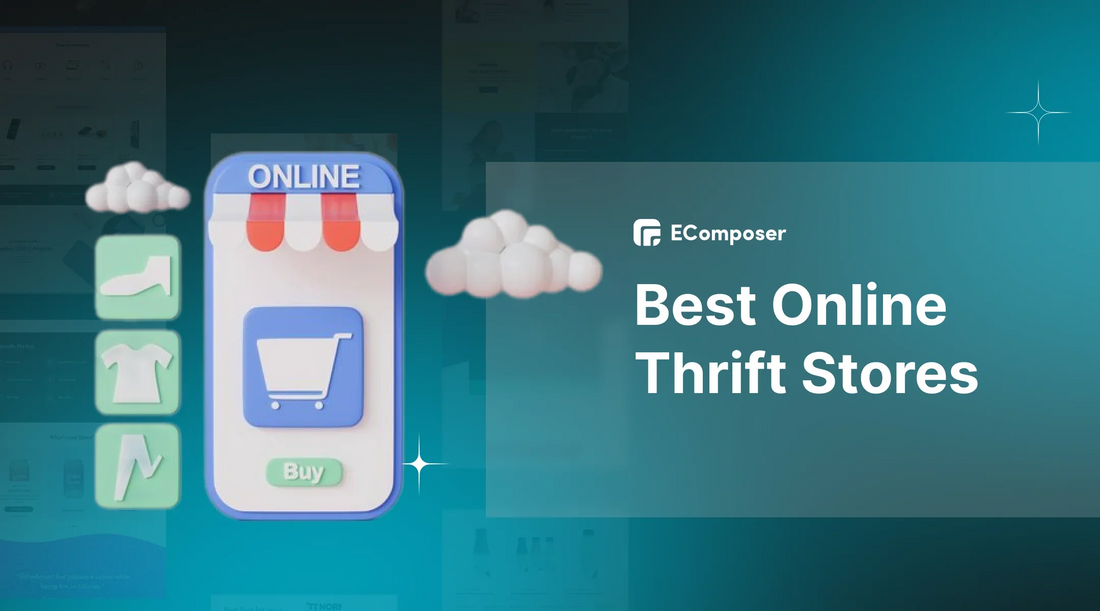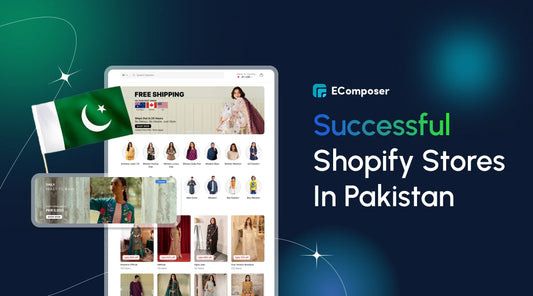15+ Best Online Thrift Stores For Resellers & Tips To Start

Table Of Contents
Let’s be real - finding reliable inventory as a reseller can feel like hunting for treasure with no map. Whether you're just starting out or already flipping fashion finds for profit, knowing where to source quality second-hand goods (without breaking the bank) is key.
That’s where online thrift stores come in. They’re not just for vintage lovers or eco-shoppers anymore; they’ve become a goldmine for resellers who know where to look.
In this guide, I’ll walk you through some of the best online thrift stores for resellers and share a few practical tips to help you source smart, sell better, and grow your resale business with confidence. Ready to turn second-hand into first-class profits? Let’s dive in.
What are Thrift Stores?
The retail world depends on thrift stores to operate as unsung champions selling gently used items at extremely affordable rates. Thrift stores contain a complete range of products including clothes and footwear alongside literature and household items and decorative additions alongside distinct unusual pieces.
These stores existed as traditional brick-and-mortar nonprofit-run and community-based establishments. But now? Digital versions of these stores have taken over the market. Online thrift stores have rapidly gained popularity by presenting a chosen collection of secondhand items that consumers can view through their home computers.
Online thrift stores present the most thrilling zone for resellers. These platforms serve daily customers but also function as top-quality sources of high-profit inventory. Competent retail resellers exploit thrift stores to obtain affordable goods which they quickly resell for profit through their shops.
And here’s the best part: many of these platforms are built with resellers in mind, offering bulk buying, searchable filters, and even rescue boxes full of surprise stock.
In short? A thrift store is more than a place to shop. It’s a smart starting point for building or scaling your resale business.
Why Merchants Should Consider Online Thrift Stores
All e-commerce business owners need new unique inventory that matches low prices and generates high profits. The answer to your diverse supply chain demands can be found in online thrift stores which might become your most valuable inventory source.
1. Low-Cost, High-Profit Inventory
Let’s start with the obvious: second-hand products usually cost a fraction of what you’d pay for new stock. For resellers, this means better profit margins — sometimes significantly better. Whether you’re selling vintage tees, branded sneakers, or quirky collectibles, you can source low and sell smart.
2. Endless Product Variety
The endless collection of products makes online thrift stores a fantastic source of inventory. The inventory on online thrift stores changes between '90s denim jackets to designer bags and mid-century lamps on different days. Fluorescent inventory from daily rotations permits your store to present fresh merchandising combinations that attract multiple customer visits.
3. Sustainable Sourcing Wins Trust
Today’s shoppers care about sustainability. Your brand will develop trustworthy relationships with customers through its alignment with environmentally responsible values when you source pre-owned items because this cuts down on waste.
4. You Can Start Small (and Scale Fast)
Unlike traditional wholesalers that require big orders upfront, many thrift platforms let you start with small batches. Want to test out a category or try a niche? Easy. Once you find what sells, you can scale up without the same financial risk.
5. Work from Anywhere, Source from Everywhere
Online thrift stores break down geographic barriers. You can sit at home and shop inventory from across the country (or the globe), then resell it right from your own Shopify or ecommerce store. It’s location-free inventory sourcing at its finest.
In short, online thrift stores give merchants the flexibility, affordability, and inventory diversity that traditional supply chains often lack. If you’re not sourcing second-hand yet, you might be leaving serious value on the table.
The Best Online Thrift Stores for merchants
1. Poshmark
Poshmark is a top U.S.-based resale marketplace with a social twist. It’s packed with fashion-forward buyers and sellers, making it perfect for merchants reselling pre-loved clothing and accessories. With tools for bundling, price drops, and community engagement, Poshmark gives you both visibility and control, ideal for anyone looking to flip fashion for profit.
Traffic:
80M+ registered users | ~40M monthly visits
(Source: Statista, SimilarWeb)
Best-Selling Products:
Women’s clothing, shoes, handbags, and activewear. Top brands: Nike, Lululemon, Free People, Levi’s, Coach.
Strategies to Succeed as a Merchant:
- List daily to stay relevant in feeds and attract fresh eyes.
- Use descriptive, SEO-rich titles (e.g., “Lululemon Align Leggings Black Size 6”) for better discoverability.
- Share your listings and others' frequently, this boosts exposure in Poshmark’s algorithm.
- Offer bundle deals to increase value per order and encourage multi-item purchases.
- Use clear, styled images, flat lays or clean, modeled photos perform best.
2. ThredUp
ThredUp is a massive online consignment store focused on women’s and kids’ fashion. Merchants love it for its “Rescue Boxes,” which offer assorted secondhand inventory at bargain prices. While it’s not a direct selling platform for small resellers, it’s an excellent sourcing hub to grab bulk items and flip them in your store or on other platforms.
Traffic:
~3.5M monthly visits
(Source: SimilarWeb)
Best-Selling Products:
Everyday women’s fashion, maternity wear, kids’ clothing. Brands like Gap, J.Crew, Madewell, and Banana Republic are top movers.
Strategies to Succeed as a Merchant:
- Buy Rescue Boxes in niche categories (e.g., denim, handbags) for targeted resale.
- Sort and inspect items carefully, clean and prep for resale to increase perceived value.
- Resell on platforms like eBay, Poshmark, or your store for higher returns.
- Track what sells best from each box to focus future sourcing.
- Time seasonal items smartly, list winter coats in fall, summer dresses in spring.
3. The RealReal
The RealReal is the go-to platform for authenticated luxury resale, think Gucci bags, Rolex watches, and designer shoes. It’s built for serious resellers with access to high-end inventory. If you’re dealing in consignment-level pieces and want a platform that handles authentication, logistics, and a wealthy buyer base, this is the place to be.
Traffic:
~5M monthly visits
(Source: SimilarWeb)
Best-Selling Products:
Luxury handbags, designer shoes, watches, and fine jewelry. Top brands: Louis Vuitton, Chanel, Gucci, Rolex, Cartier.
Strategies to Succeed as a Merchant:
- Source luxury items with proof of authenticity, receipts, tags, or serial numbers.
- Use The RealReal’s consignment service to tap into their buyer base and logistics.
- Understand their commission structure, higher-value items earn better payouts.
- Focus on timeless or trending designer pieces that hold value.
- Use rejected items (if any) for resale on your store or marketplaces like eBay.
4. Depop
Depop is a mobile-first resale app with a strong Gen Z following. It’s a fashion playground for vintage, Y2K, streetwear, and handmade pieces. For merchants targeting trend-driven buyers, Depop offers massive potential. The visual, Instagram-like layout and social features make it perfect for creative resellers with a niche and an eye for aesthetics.
Traffic:
~10M monthly visits
(Source: SimilarWeb)
Best-Selling Products:
Y2K fashion, vintage Levi’s, graphic tees, handmade jewelry, streetwear brands (Nike, Adidas, Champion).
Strategies to Succeed as a Merchant:
- Build a strong brand aesthetic: your shop should have a consistent style and vibe.
- Use bold, scroll-stopping visuals: think of your listing photos like mini Instagram posts.
- Hashtag wisely: use trending, product-specific hashtags to get discovered.
- Engage with followers through messages, likes, and shares to build loyalty.
- Price for Gen Z budgets: aim for trendy, affordable items with high perceived value.
5. Swap.com
Swap.com is an online thrift store offering secondhand fashion for the whole family, women, men, kids, and maternity. It’s a great platform for sourcing bulk inventory at low cost. While they don’t have the flash of trend-driven sites, they’re ideal for resellers looking for basics, essentials, and steady, evergreen clothing to flip.
Traffic:
~300K monthly visits
(Source: SimilarWeb)
Best-Selling Products:
Casual women’s and kids' apparel, activewear, maternity wear, and basic name brands like Old Navy, Carter’s, and H&M.
Strategies to Succeed as a Merchant:
- Use their bulk inventory and sale sections to source low-cost items for higher-margin resale.
- Focus on evergreen, practical pieces: maternity, kids’ wear, and loungewear are always in demand.
- Bundle purchases to reduce the cost per unit and increase profit margins.
- Refresh and repackage items (e.g., steaming, new photos) to improve presentation.
- Cross-list on multiple platforms (Poshmark, Facebook Marketplace) to maximize reach.
6. eBay
eBay is the original global resale giant, with millions of active buyers searching for everything from vintage clothes to collectibles. It’s flexible, well-established, and ideal for resellers who want to test multiple categories. Whether you're flipping fashion, electronics, or unique finds, eBay offers massive visibility and solid infrastructure for sellers of all sizes.
Traffic:
~1.2B monthly visits globally
(Source: SimilarWeb)
Best-Selling Products:
Vintage apparel, branded sneakers, watches, collectibles, and electronics. Top fashion brands: Nike, Patagonia, Levi’s, Coach.
Strategies to Succeed as a Merchant:
- Optimize listings with keyword-rich titles and clear, detailed descriptions.
- Use high-quality, professional-looking photos, blurry or dark images kill conversions.
- Offer competitive shipping and return policies to build buyer trust.
- Leverage auctions for rare items and fixed pricing for everyday products.
- Use eBay’s analytics tools to track sales, buyer behavior, and listing performance.
7. Etsy (Vintage Section)
Etsy is best known for handmade goods, but its vintage section is a goldmine for resellers of retro fashion, accessories, and decor. If you sell items that are 20+ years old and have unique character, Etsy gives you a global stage. Buyers here value story, aesthetic, and originality, perfect for merchants with a creative, curated eye.
Traffic:
~470M monthly visits globally
(Source: SimilarWeb)
Best-Selling Products:
Vintage denim, retro graphic tees, leather bags, 80s–90s fashion, costume jewelry, and home decor.
Strategies to Succeed as a Merchant:
- List only items 20+ years old, Etsy requires this for vintage.
- Tell a story in your product descriptions, buyers love history and context.
- Use SEO-rich titles (e.g., “90s Levi’s 501 High-Waisted Jeans – Size 28”).
- Create a cohesive shop aesthetic to stand out and earn trust.
- Tag your items properly using keywords like “retro,” “Y2K,” or “boho vintage” to boost discoverability.
8. Vinted
Vinted is a popular peer-to-peer resale platform with a strong European base. It’s great for merchants sourcing casual, secondhand fashion or reselling fast fashion and mid-tier brands. With no selling fees and a mobile-friendly setup, it’s beginner-friendly and ideal for flipping affordable pieces at volume, especially if you’re based in or selling to Europe.
Traffic:
~45M monthly visits
(Source: SimilarWeb)
Best-Selling Products:
Everyday wear, fast fashion (Zara, H&M, ASOS), branded casuals (Adidas, Levi’s), and outerwear.
Strategies to Succeed as a Merchant:
- Focus on low-cost, fast-moving inventory, volume is key on Vinted.
- Price competitively, buyers here are budget-conscious and compare easily.
- Offer bundles and discounts to increase cart size and move more stock.
- Use natural-light, clean product photos, it’s a visual-first platform.
- Respond quickly to messages to build credibility and improve your seller rating.
9. Mercari
Mercari is a U.S.-based resale app that’s become a go-to for casual sellers and resellers alike. It’s flexible, fast, and supports a wide range of categories; from fashion to electronics. For merchants, Mercari is great for testing new products, clearing excess inventory, and selling across fashion and lifestyle niches without upfront listing fees.
Traffic:
~15M monthly visits (U.S.)
(Source: SimilarWeb)
Best-Selling Products:
Sneakers, women’s fashion, electronics, collectibles, handbags, and kids’ items.
Strategies to Succeed as a Merchant:
- List items with suggested pricing to match what’s currently selling.
- Use “Smart Pricing” (Mercari’s auto-adjust tool) to stay competitive.
- Ship quickly, Mercari favors fast shippers in its algorithm and badges.
- Use keyword-rich titles for better visibility in search and discovery.
- Relist slow-moving inventory, Mercari gives priority to fresh listings.
10. Grailed
Grailed is a curated menswear resale platform known for streetwear, designer fashion, and cult-favorite brands. If you specialize in men’s vintage, hype brands, or luxury resale, this is a powerful niche marketplace. With a loyal buyer base and high average order value, it’s a great spot for resellers looking to flip men’s fashion with style.
Traffic:
~3.2M monthly visits
(Source: SimilarWeb)
Best-Selling Products:
Supreme, Nike, Stone Island, Rick Owens, Levi’s, vintage band tees, and designer sneakers.
Strategies to Succeed as a Merchant:
- List designer or hype pieces with proof of authenticity: buyers are brand-savvy.
- Use model numbers or collection names in titles to attract niche buyers (e.g., “Yeezy 700 Wave Runner OG”).
- Provide measurements, not just sizing: accuracy is a must for fit-conscious customers.
- Use clean, neutral backdrops: aesthetic consistency builds brand trust.
- Price strategically: some items sell high price, but overpricing can stall traction.
11. ASOS Marketplace
ASOS Marketplace is the indie sibling of the ASOS fashion empire. It’s a curated platform for vintage and independent boutiques. While onboarding is more selective, it’s ideal for resellers with a strong brand identity and a curated, fashionable collection of second-hand pieces. If you're running your label or vintage brand, this is a perfect fit.
Traffic:
~1.1M monthly visits
(Source: SimilarWeb)
Best-Selling Products:
Vintage Levi’s, branded jackets, 90s/Y2K trends, retro dresses, and curated boutique apparel.
Strategies to Succeed as a Merchant:
- Apply as a boutique with a clearly defined style and product category (vintage or reworked).
- Maintain consistent branding: photography, store name, and voice all matter here.
- Curate high-quality, clean vintage pieces, ASOS Marketplace buyers are style-conscious.
- Tag trends accurately (e.g., “Y2K crop top” or “90s bomber jacket”) to improve search visibility.
- Offer worldwide shipping to appeal to their international audience.
12. Goodfair
Goodfair is a mission-driven online thrift store that sells mystery bundles of secondhand clothing at unbeatable prices. Their “no new things” motto appeals to eco-conscious shoppers and resellers. If you’re okay with some surprises, Goodfair is a low-risk way to score inventory in bulk and resell items individually for profit across other platforms.
Traffic:
~200K monthly visits
(Source: SimilarWeb)
Best-Selling Products:
Vintage tees, flannels, windbreakers, denim, branded basics (Champion, Adidas), and upcycling-friendly pieces.
Strategies to Succeed as a Merchant:
- Buy themed mystery bundles (e.g., “90s Tees,” “Vintage Denim”) for curated resale categories.
- Break up bundles and resell individually on Depop, Poshmark, or your own Shopify store.
- Rework or upcycle pieces (add patches, crop, dye) for higher resale value.
-
Photograph with styling in mind, plain items can pop with the right presentation.
- Emphasize sustainability in your marketing to align with conscious consumers.
13. Patagonia Worn Wear
Patagonia Worn Wear is the official resale platform for pre-owned Patagonia gear. It's built for circular fashion, offering high-quality outdoor apparel with plenty of life left. While the inventory is niche, it’s ideal for resellers in the outdoor or eco-conscious niche. Patagonia’s reputation means items hold value and sell quickly when listed on broader platforms.
Traffic:
~100K monthly visits
(Source: SimilarWeb)
Best-Selling Products:
Fleeces, down jackets, rain shells, backpacks, and base layers, all branded Patagonia.
Strategies to Succeed as a Merchant:
- Source from Worn Wear and resell on platforms like eBay or your Shopify store at marked-up prices.
- Focus on outerwear - jackets and fleeces tend to flip fast, especially in colder months.
- Highlight Patagonia’s eco-values in your listings, buyers love the brand’s mission.
- Target outdoor gear shoppers: hikers, travelers, and students are strong markets.
- Bundle smaller items like hats or tees for added value and faster shipping.
14. Rebag
Rebag is a premier online destination for luxury bags, watches, and accessories, all authenticated and ready for resale. It’s designed for fashion-forward shoppers but also offers great opportunities for resellers who specialize in high-end goods. With a sharp focus on condition and authenticity, Rebag is perfect for merchants looking to invest in fewer, higher-margin flips.
Traffic:
~400K monthly visits
(Source: SimilarWeb)
Best-Selling Products:
Chanel, Louis Vuitton, Gucci, Fendi, Rolex, and high-end accessories like sunglasses or wallets.
Strategies to Succeed as a Merchant:
- Buy during sales or use Rebag’s credit system to save on repeat purchases.
- Track trending luxury styles: tote bags, crossbodies, and mini bags tend to move fastest.
- Resell on your own branded site or platforms like The RealReal or Tradesy to maximize returns.
- Verify and document authenticity: original dust bags, cards, or serial numbers help resale value.
- Build a luxury-focused brand identity to build trust with high-ticket buyers.
15. Refashioner
Refashioner is a storytelling-driven vintage resale site that curates unique pieces with soul - think rare finds, upcycled fashion, and one-of-a-kind vintage. While it’s not as well-known, it’s an excellent platform for boutique sellers who want to present their items in a more editorial, slow-fashion environment. Ideal for high-touch resellers who value aesthetic and niche curation.
Traffic:
~50K monthly visits (low, but highly targeted)
(Source: SimilarWeb)
Best-Selling Products:
Statement vintage dresses, rare designer vintage, upcycled apparel, one-off jackets, and accessories with a backstory.
Strategies to Succeed as a Merchant:
- Choose items with personality: bold prints, unique cuts, vintage labels.
- Tell the story of each item in the listing description: make it personal and narrative-driven.
- Invest in editorial-style photos: lifestyle shots sell better than plain flat lays here.
- Price for value, not speed: Refashioner’s shoppers pay for uniqueness.
- Use it to build brand credibility as a premium vintage curator.
How to Choose the Best Thrift Suppliers for Reselling
With so many online thrift stores out there, choosing the right one for your reselling business isn’t just about what looks good; it’s about what works for you. Not all suppliers are created equal, and picking the wrong one can mean low margins, mismatched inventory, or slow-moving stock.
Here’s how to make smart, strategic choices that align with your goals:
1. Know Your Niche (and Your Buyer)
Start by getting super clear on what you sell and who you sell it to. Are you all about vintage streetwear? Kids’ bundles? High-end bags?
Once you define that, you’ll know whether your supplier needs to be Depop-cool, Patagonia-sustainable, or Rebag-luxury.
➡ Tip: Don’t chase what’s trending. Choose suppliers that match your existing style or the niche you plan to grow into.
2. Check Inventory Quality and Variety
Photos don’t always tell the full story. Look for platforms with clear item descriptions, return policies, and multiple photos per product.
If you're buying in bulk or mystery boxes (like from Goodfair or ThredUp), read reviews from other resellers to gauge consistency.
➡ Tip: Order a small test batch first. It’s a low-risk way to assess item condition, brand mix, and shipping speed.
3. Evaluate Pricing and Profit Margins
It’s not a good deal if there’s no room for profit. Always factor in shipping costs, listing fees, and how much time/effort goes into prepping each item for resale.
Some suppliers offer great prices but need more cleaning or photography work - be honest about what you can manage.
➡ Tip: Track your average cost-per-item vs. average resale price. If you’re under a 40% margin, it’s time to rethink sourcing.
4. Check Shipping Times and Return Policies
Delayed shipping can ruin your workflow, especially if you’re flipping items fast. Choose platforms with transparent fulfillment windows and fair return options in case inventory arrives damaged or unusable.
➡ Tip: Platforms like Poshmark and Mercari offer built-in shipping, super handy if you want simplicity.
5. Look for Seller-Friendly Tools and Support
The best platforms for merchants go beyond product listings; they offer insights, filters, bulk buying options, and seller dashboards. Tools that help you save time and scale make a big difference in your workflow.
➡ Tip: Some sites (like ThredUp) have business-focused features like Rescue Boxes, while platforms like eBay offer robust analytics.
You don’t need the “perfect” thrift supplier; you need one that fits your process, brand, and profit goals. Start small, test often, and keep optimizing. The more you learn what sells, the easier it is to spot gold when you’re sourcing.
Guide to Start Your Online Thrift Store
1. Pick a Niche That Suits You
Don’t try to sell everything to everyone; it’s tempting, but overwhelming. The most successful resellers start with a clear niche:
- Vintage denim
- Designer handbags
- Kidswear bundles
- Streetwear or hype fashion
- Eco-friendly outdoor gear
➡ Tip: Choose what you enjoy sourcing and can talk about confidently. Passion makes your brand more authentic.
2. Source Your Inventory Wisely
You can start by selling products that you already own or doing a quick thrift haul at local stores. Once you're ready to scale, look into sourcing from online platforms.
➡ Tip: Always calculate your profit margin before buying, aim to buy for 20–30% of your target resale price.
3. Choose the Right Selling Platform
You don’t need a fancy website to start, you just need one that works for you. Many sellers get started on platforms that already have built-in traffic.
If you decide to go with Shopify, EComposer is a great way to easily build a professional, custom-looking online store without needing any coding skills. Once your store is up and running, using EcomRise can help you maximize sales with upsell tools, things like offering bundles or post-purchase discounts that make it easy to increase your order value.
➡ Tip: Start with 1–2 platforms, master them, then consider expanding. Once you’re ready, bringing everything to your own branded store is a great next step.
4. Create Killer Listings That Actually Sell
This is where the magic happens. Every listing should include:
- Clear, well-lit photos (multiple angles!)
- Accurate sizing and condition details
- SEO-friendly title (e.g., “Levi’s 501 Vintage Jeans – High Waist – Size 28”)
- Short, honest description with styling or use ideas
➡ Tip: Think like a buyer, would you click and trust your listing?
5. Build Trust & Stay Consistent
Your store doesn’t grow overnight, but consistency compounds. Build customer trust by:
- Responding quickly to questions
- Shipping orders on time
- Leaving thank-you notes or extras
- Asking for reviews and reposts
➡ Tip: Post new items regularly, even just a few per week keeps your shop active in the algorithm.
Bonus: Brand It Like a Pro
Once you’ve got momentum, treat your thrift store like a real brand. Think about:
- A memorable name
- A simple logo or store banner
- Consistent photo style or tone of voice
- Maybe even packaging that’s fun or eco-friendly
➡ Tip: Branding isn’t about being fancy - it’s about being recognizable.
Tips for Maximizing Sales on Online Thrift Stores
Sourcing great thrifted pieces is only half the game, the real win comes when you know how to sell smarter, faster, and more consistently. Whether you're flipping on Poshmark, Depop, or your site, these tips will help you squeeze the most value out of every item in your inventory.
1. Take Photos That Actually Sell
Your product photos are your storefront - make them count. You don’t need a pro camera, just good lighting (natural light works wonders), a clean background, and multiple angles.
➡ Quick tip: Include at least five photos per item: front, back, close-up of the label, fabric/texture, and any flaws (be honest - it builds trust).
2. Write Listings That Speak to Real Buyers
Skip the fluff. Use keywords that shoppers are actually typing and make your title searchable (brand + item + style + size). Then write a short, clean description covering fit, fabric, and condition.
➡ Example title: “Vintage Carhartt Chore Jacket – Brown Canvas – Size L”
➡ Bonus: Mention styling ideas or who it's great for - “Perfect for layering or workwear looks.”
3. Price with Strategy (Not Emotion)
Yes, that vintage tee is cool. But pricing it too high will leave it sitting for months. Check comps (similar sold listings) and price competitively. Leave wiggle room for offers and bundles.
➡ Tip: Bundle discounts (like 15% off 2+) are great for clearing more inventory at once.
4. Post Regularly - Even in Small Batches
Consistency is your best friend. Listing a few items daily or every few days signals to the platform’s algorithm that your shop is active. You’ll get more visibility, which means more eyes and sales.
➡ Tip: If you're short on time, schedule listings ahead using tools like Vendoo or list directly via mobile during free moments.
5. Offer Great Customer Service (Yes, Even in Resale)
Fast replies, honest listings, quick shipping, and thoughtful packaging all add up. It’s what turns one-time buyers into repeat customers.
➡ Bonus idea: Add a handwritten thank-you note or a discount code for their next order, it’s simple, and it works.
6. Learn From What Sells (And What Doesn’t)
Track your sales. Notice which brands, styles, or price points move fastest. The more you understand your best-sellers, the easier it gets to source items that flip fast.
➡ Tip: Keep a simple spreadsheet or use seller dashboards on platforms like eBay or Poshmark to analyze trends.
7. Get Social With It
Want to go beyond marketplace traffic? Build an Instagram or TikTok presence around your shop. Share behind-the-scenes content, styling tips, or new arrivals, it helps build a real community around your brand.
➡ Hashtags + storytelling = visibility + trust. Simple but powerful.
Ready to build your online thrift store?
Starting and scaling an online thrift store isn’t about luck, it’s about strategy, consistency, and knowing where to source smart. With the right platforms, a clear niche, and a seller mindset, you can build a resale business that’s both profitable and sustainable. Start small, stay consistent, and keep testing what works. There’s real opportunity in secondhand, you just need to thrift with intention. Start sourcing smart, share your wins, and drop your favorite thrift platform in the comments. Let’s grow this resale game together.





















0 comments